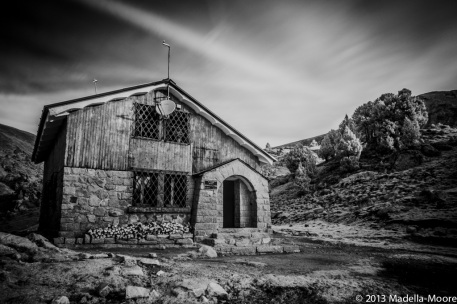Infrared and the Olympus OM-D E-M5
Infrared photography can add a unusual take on images, dramatically changing the emphasis on features in landscapes and foliage. While you can convert a camera to infrared by removing its hot-mirror, you can also get quite acceptable results using just a simple filter on the front of an unmodified camera and lens.
The above image was taken with an Olympus OM-D E-M5 with the standard 12-50mm kit lens and a Hoya 52mm R72 Infrared filter attached. The filter blocks almost all visible light, and looks almost completely black:
Here is the original image, taken without the filter attached – a fairly typical scene of a mountain refuge in the Pyrenees:
Adding the filter increases the exposure time from 1/160th to 30 seconds (keeping the camera at its base ISO of 200). That’s about 12 stops of attenuation – comparable to some of the more extreme ND filters.
This is the infrared image straight out of camera. Unsurprisingly, there is little colour left aside from the red channel, as most of the normal colour in the scene has been heavily filtered out. Due to the Bayer colour filter on the camera sensor I think that this also tends to reduce the apparent resolution when compared to a normal colour image, as fewer of the raw pixels have useful brightness. The purple haze in the centre of the image is possibly due to IR reflections inside the camera/lens – much like the dreaded purple flare that sometimes causes problems with wide angle lenses on Olympus cameras.
Some experimentation with white balance and a custom camera profile for Lightroom (the white balance is outside of Lightroom’s normal range…) yields a better result, where you can clearly see the brightening of the grass and leaves in the scene, but which is still very alien:
The image is very noticeably softer than the unfiltered colour shot. The inherently longer wavelengths used are lower resolution and the lens is not optimised for IR. But I suspect that the main resolution loss of down to the CFA (Colour Filter Array) in front on the sensor, where presumably the green and blue sites are much less sensitive than the red.
Finally, the image was processed to Black and White and the contrast and clarity pushed to help compensate for the resolution loss:
Overall, the results are quite reasonable. The main difficulties lie in the long exposure times – a tripod is essential, even in good light.
There are a few more images taken and processed in to the same style over at 500px.






Interesting, I presume it could be achieved with filter (combinations) in PS? without the need of a filter even…or am I getting things too complicated?!
You can get quite close by taking a colour image, converting it to black and white, and then selectively boosting colour channels (for example, green) using an editor such as Lightroom or Capture One (which has much more precise colour editing controls). However, the effect is not quite the same, as the IR does not exactly correlate with the non-IR colours – which is why, for example, some types of vegetation survey combine both conventional and IR images to detect new plant growth.